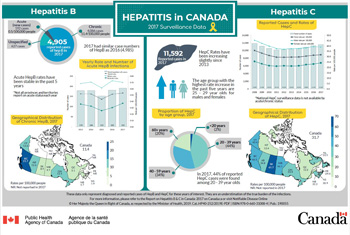Hepatitis in Canada: 2017 surveillance data

Download the alternative format
(PDF format, 473 KB, 1 page)
The Public Health Agency of Canada collects information on reported cases of hepatitis B and hepatitis C infection through the Canadian Notifiable Diseases Surveillance System (CNDSS).
Hepatitis B
- In 2017, 4,905 cases of hepatitis B were reported in Canada:
- 192 acute cases (corresponding to a rate of 0.5 per 100,000 people)
- 4,086 chronic cases (corresponding to a rate of 11.4 per 100,000 people)
- 627 unspecified cases
- 2017 had similar case numbers of hepatitis B as 2016, when 4,985 cases were reported.
- Rates of reported acute hepatitis B cases have been stable from 2013 to 2017.
- There were between 152 and 192 acute cases reported per year in this time period.
- The corresponding average rate was 0.5 per 100,000 people.
- Male rates of reported acute hepatitis B cases were higher than female rates between 2013 and 2017.
- The average male rate was 0.69 per 100,000 people while the average female rate was 0.32 per 100,000 people.
- In 2017, rates of reported chronic hepatitis B cases above the national Canadian rate of 11.4 per 100,000 people were found in:
- British Columbia (21.7)
- Alberta (12.6)
- the Yukon (12.6)
- Ontario (12.5)
- In 2017, rates of reported chronic hepatitis B cases below the national rate were reported in:
- Manitoba (9.7)
- Saskatchewan (8.9)
- New Brunswick (5.7)
- Quebec (5.1)
- Nova Scotia (1.9)
- Newfoundland and Labrador, the Northwest Territories, Nunavut and Prince Edward Island did not report on chronic hepatitis B in 2017.
Hepatitis C
- In 2017, 11,592 cases of hepatitis C were reported in Canada.
- The average Canadian rate of reported hepatitis C cases over 2008-2017 was 31.1 per 100,000 people.
- Male rates were higher than female rates between 2008 and 2017.
- The corresponding average rates were 39.4 per 100,000 people for males and 22.6 per 100,000 people for females.
- Reported rates of hepatitis C have been increasing slightly in recent years, from 29.5 per 100,000 in 2013 to 31.7 per 100,000 people in 2017.
- The age group with the highest rate increase over 2013-2017 was the 25 to 29 year olds, for both males and females.
- In 2017, 44% of reported hepatitis C cases were found among 20-39 year olds.
- One-third (34%) of cases were found among those age 40-59 years while 20% of cases were reported in 60+ years.
- Cases less than 20 years old accounted for 2% of all reported hepatitis C.
- In 2017, rates of reported hepatitis C cases above the national Canadian rate of 31.7 per 100,000 people were found in:
- Saskatchewan (61.7)
- British Columbia (46.5)
- Manitoba (46.1)
- Yukon (45.4)
- Alberta (34.8)
- Newfoundland and Labrador (33.5)
- Ontario (33.4)
- New Brunswick (32.2)
- In 2017, rates of reported hepatitis C cases below the national rate were reported in:
- Nova Scotia (30.9)
- Prince Edward Island (24.6)
- the Northwest Territories (13.4)
- Quebec (12.3)
- Nunavut did not report on hepatitis C in 2017.
These data only represent diagnosed and reported cases of HepB and HepC for these years of interest. They are an underestimation of the true burden of the infections.
For more information, please refer to the Report on Hepatitis B and C in Canada: 2017 on Canada.ca or visit Notifiable Disease Online.
Page details
- Date modified: